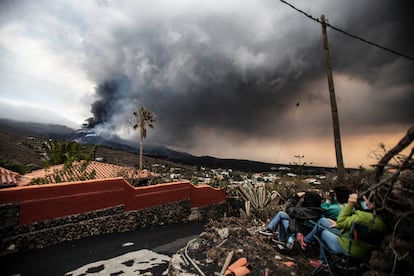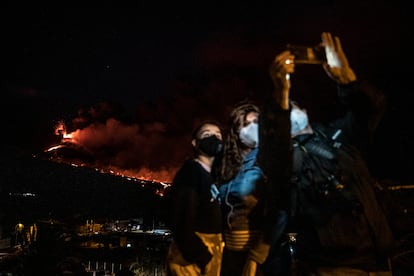Weekend getaway to La Palma: The volcano tourists flocking to see the eruption
Residents of the Spanish island are annoyed by the influx of visitors, while the tourism industry warns this is just a short-term situation and that the outlook for the sector is bleak

Parked cars are lined up one after another on Tajuya street, a small avenue on La Palma, in Spain’s Canary Islands. A tourist has even parked in front of a garage of a one-story home in the Tacande neighborhood in the town of Los Llanos de Aridane, even though this area is restricted to locals. A few meters away, the Sagrada Familia parish church has become the epicenter for tourists hoping to see the new volcano on La Palma, which has been erupting since September 19. Curious visitors look for any spot to leave their rental cars. A woman in her thirties yells at a tourist to remove her vehicle. The tourist refuses. “If they don’t want me to park, I’ll pay an entrance fee,” they say, despite having broken through to the restricted area.
Tourists on weekend getaways to see the volcano are filling up the streets and restaurants of La Palma. Hotels are putting up “no vacancy” signs and there are no spots left on the planes and ferries traveling to the island, particularly the ships from Puerto de Los Cristianos in Tenerife, which is also part of the Canaries archipelago, located off the coast of northwestern Africa. Three sisters from Tenerife have come with their mother to see the volcano. They say they are against volcano tourism, but couldn’t resist seeing the phenomenon that has caused so much devastation in person. They collect ash and store it in a bag; they want to conserve a part of what is, for now, the newest territory on the planet. “All our life they have told us in school that we live on volcanic lands, but we never thought that we would experience it,” says Candela, 26, the eldest of the sisters. From the car, their mother warns them: “Put on the protective glasses, it’s raining ash.”
But the image offered by these bustling weekends is misleading. The number of hotel beds available on La Palma has been significantly reduced by the coronavirus crisis, which saw tourist numbers fall to record lows. Official data from the Canaries Statistics Institute paints a dire picture: while in January 2020, before the pandemic, there were 8,000 beds available in the archipelago, now that figure is just 4,855. “Many establishments have closed,” explains Carlos García Sicilia, the vice president of the hotel association Ashotel on La Palma and manager of Hacienda San Jorge hotel in Los Cancajos, in the east of the island. Of the 123 establishments that were open in La Palma in March 2020, only 49 still have their doors open. “The result: the supply has fallen quite a lot,” explains García Sicilia.

Then there are the hotels that are not open for tourists such as the Princess Hotel, which is being used to accommodate 439 locals who have been forced to leave their homes due to the eruption. Then there is Meliá Sol, built in 1990, in the neighborhood of Puerto Naos, which was evacuated the day the eruption began. Among the evacuees from Puerto Naos were 500 tourists who were staying at the hotel, which came within just one kilometer of the lava flow. “We are not closed, we are evacuated,” says Sébastien Broué, the managing director of Melía Sol.
“Right now we are managing an emergency and actively working on ways to support our 110 employees [who have been offered psychological assistance] and the island, and are thinking about what happens next,” says Broué. The hotel chain has relocated evacuated staff and guests to their establishments in the south of Tenerife and is now trying to help address the crisis on La Palma, by donating food and providing chefs for World Central Kitchen, a non-for-profit founded by Spanish chef José Andrés. Since September 23, Andrés has been working on the island to provide food for both the communities affected by the eruption and the emergency teams.
Less demand
While La Palma may fill with visitors on the weekend, tourist demand has also fallen. “Throughout the week, the occupancy rate is between 30% and 40%,” says García Sicilia, meaning that he is working “at a loss.” The big problem is cancellations from tour operators who provide 90% of visitors in the high season. “They are canceling trips due to the insecurity over air connectivity,” explains García Sicilia. According to the hotel manager, the tour operator Condor has canceled all its operations to La Palma until further notice. “The outlook is uncertain,” he says. “It all depends on how long the volcano lasts.”
The new volcano on La Palma has entered its sixth week of eruption. Seismic activity continues to intensify, and according to María José Blanco, the spokesperson of the Canaries Volcano Prevention Plan (Pevolvca), the island could be hit with an earthquake measuring 6 on the Richter scale. A sixth volcanic vent opened up on Monday, and part of the cone collapsed, leading to greater outpourings of lava.
While the island has seen an influx of weekend visitors, business brought in by tour operators is more profitable for the tourism sector. “Those who come on the weekend don’t spend as much,” says María, a hypermarket worker. “Circumstantial tourism helps, of course, but it does not solve our problems,” adds García Sicilia.
It’s nighttime and the pubs in the center of Los Llanos de Aridane are filled with locals and tourists. In an Argentine restaurant in the center of the town, a group of friends who have traveled from Tenerife divide into two groups: those who want to go see the volcano and those who want a gin and tonic. “It would be a sin not to have come given it’s so close,” says Manuel, a 48-year-old art professor. He and a friend have rented an apartment in a nearby street for €35 a night. While he may consider not seeing the eruption a “sin,” he and his friend are with the group who wants a cocktail.
Tu suscripción se está usando en otro dispositivo
¿Quieres añadir otro usuario a tu suscripción?
Si continúas leyendo en este dispositivo, no se podrá leer en el otro.
FlechaTu suscripción se está usando en otro dispositivo y solo puedes acceder a EL PAÍS desde un dispositivo a la vez.
Si quieres compartir tu cuenta, cambia tu suscripción a la modalidad Premium, así podrás añadir otro usuario. Cada uno accederá con su propia cuenta de email, lo que os permitirá personalizar vuestra experiencia en EL PAÍS.
¿Tienes una suscripción de empresa? Accede aquí para contratar más cuentas.
En el caso de no saber quién está usando tu cuenta, te recomendamos cambiar tu contraseña aquí.
Si decides continuar compartiendo tu cuenta, este mensaje se mostrará en tu dispositivo y en el de la otra persona que está usando tu cuenta de forma indefinida, afectando a tu experiencia de lectura. Puedes consultar aquí los términos y condiciones de la suscripción digital.
More information

New areas evacuated on La Palma as lava destroys more homes

One month on, La Palma volcano continues to cause destruction
Últimas noticias
Most viewed
- Sinaloa Cartel war is taking its toll on Los Chapitos
- Reinhard Genzel, Nobel laureate in physics: ‘One-minute videos will never give you the truth’
- Oona Chaplin: ‘I told James Cameron that I was living in a treehouse and starting a permaculture project with a friend’
- Why the price of coffee has skyrocketed: from Brazilian plantations to specialty coffee houses
- David King, chemist: ‘There are scientists studying how to cool the planet; nobody should stop these experiments from happening’








































